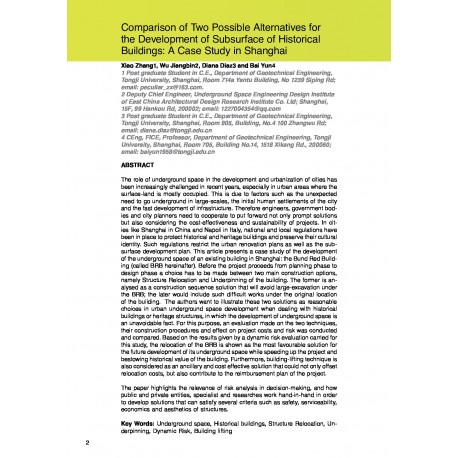Cart
0
0
No document
0,00 €
Total
Document successfully added to your shopping cart
Quantity
Total
There are 0 items in your cart.
There is 1 item in your cart.
Total documents
Total shipping
To be determined
Total
Search & filter
Search for a publication
Search & filter

Comparison of Two Possible Alternatives for the Development of Subsurface of Historical Buildings: A Case Study in Shanghai
481_comparison_of_two_possible_a
X. Zhang / J. Wu / B. Yun / D. Diaz
The role of underground space in the development and urbanization of cities has been increasingly challenged in recent years, especially in urban areas where the surface-land is mostly occupied. This is due to factors such as the unexpected need to go underground in large-scales, the initial human settlements of the city and the fast development of infrastructure. Therefore engineers, government bodies and city planners need to cooperate to put forward not only prompt solutions but also considering the cost-effectiveness and sustainability of projects. In cities like Shanghai in China and Napoli in Italy, national and local regulations have been in place to protect historical and heritage buildings and preserve their cultural identity. Such regulations restrict the urban renovation plans as well as the subsurface development plan. This article presents a case study of the development of the underground space of an existing building in Shanghai: the Bund Red Building (called BRB hereinafter). Before the project proceeds from planning phase to design phase a choice has to be made between two main construction options, namely Structure Relocation and Underpinning of the building. The former is analysed as a construction sequence solution that will avoid large-excavation under the BRB; the later would include such difficult works under the original location of the building. The authors want to illustrate these two solutions as reasonable choices in urban underground space development when dealing with historical buildings or heritage structures, in which the development of underground space is an unavoidable fact. For this purpose, an evaluation made on the two techniques, their construction procedures and effect on project costs and risk was conducted and compared. Based on the results given by a dynamic risk evaluation carried for this study, the relocation of the BRB is shown as the most favourable solution for the future development of its underground space while speeding up the project and bestowing historical value of the building. Furthermore, building-lifting technique is also considered as an ancillary and cost effective solution that could not only offset relocation costs, but also contribute to the reimbursement plan of the project. The paper highlights the relevance of risk analysis in decision-making, and how public and private entities, specialist and researches work hand-in-hand in order to develop solutions that can satisfy several criteria such as safety, serviceability, economics and aesthetics of structures.


